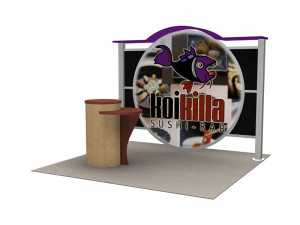R & D: Seven (Not so Simple) Steps
Just writing “Seven Steps” makes it sound so simple, like it has a defined start and finish. But if you do much of it, you know it’s a living, breathing thing that never really rests. To stay ahead, you have to constantly be thinking of innovative and practical designs for your customers (See Design Monday this week for example).
Coming off my last trip that living, breathing thing was full of life. This week was all about intensive R & D planning on a series of exciting products rolling out over the next nine months. More products in a compressed time frame than I can ever remember.
So, how do you approach R & D? What are some of the steps you take? For me, I try to keep it the same and maintain a process.
My basic steps are:
- Develop a basic idea with a trusted team of people and partners. These can be vendors, Classic Exhibits employees from various departments, customers, or all of the above.
- Put the concept to paper with a great design team. I like to utilize both internal and external designers and engineers for this step. It gives you the best shot at something truly unique and infuses it with several different design perspectives.
- Give the designs to a trusted group of builders/creators: our Production Engineer, shop guys, and project managers. 🙂
They know how to transform the impractical into the practical and how to re-engineer the needlessly complex into the real world simple. - Get input on the initial product demos from trusted industry partners and customers. This is the tire kicking step. Will it sell and does it function according to plan? Then send it on the road to see if it’s durable.
- Rework it after you receive feedback.
- Turn over the final product details to Marketing to make it pretty on paper and e-broadcasts.
- Release the product to the Distributor Network.
Now as I re-read those Seven Steps, it seems too simple, and we all know it’s not. More than anything, if you take the time to ask for input from a trusted team inside your own building and a trusted team inside your industry network, you give yourself the best chance at success. But even with all that, sometimes products never really take off . . . or at least take a long time to take off. Look at the Visionary Designs VK-1017 for example. We spent a long time developing that kit, and it was just one kit. After we released it, it did nothing for nearly two years. Yet, when we were developing it, we were convinced that it would be a home run.
That was over three years ago. Now it sells quite well and is a very popular kit. So you never know what will be an immediate hit, what will fail, and what will take months or years to find an audience.
Take the Perfect 10 — a great example of a product line where we followed all Seven Steps to a “T.” And once released, it clicked conceptually. People loved it! Loved the design . . . loved the price . . . loved the packaging . . . loved it all.
In the end, I will always follow the Seven Steps, even though they are not so simple. I believe it gives us the best chance at success as we develop new products and designs.
How about you? What are your thoughts about Research and Development in our industry? Please comment.
Be well and have a safe and restful weekend.
–Kevin Carty
http://twitter.com/kevin_carty
http://www.linkedin.com/pub/kevin-carty/3/800/32a





